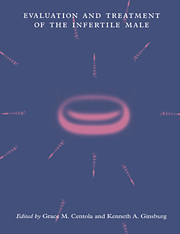Book contents
- Frontmatter
- Contents
- Preface
- List of contributors
- 1 Andrology
- 2 Sperm–egg interaction
- 3 Routine semen analysis
- 4 Computer-aided sperm analysis: a critical review
- 5 Antisperm antibodies: diagnosis and treatment
- 6 The sperm penetration assay
- 7 Intrauterine insemination for male factor
- 8 Processing human semen for insemination: comparison of methods
- 9 New assays for evaluating sperm function
- 10 Assisted reproductive technology for male factor infertility
- 11 Microinjection techniques for male infertility
- 12 Therapeutic donor insemination: screening, indications and technique
- 13 Endocrine assessment and hormone treatment of the infertile male
- 14 The urologic evaluation of the infertile male
- 15 Azoospermia: the diagnosis and treatment
- 16 White blood cells in semen and their impact on fertility
- 17 Psychological aspects of male infertility: lifting the shroud of shame
- 18 Evaluation of the female partner
- Index
9 - New assays for evaluating sperm function
Published online by Cambridge University Press: 16 September 2009
- Frontmatter
- Contents
- Preface
- List of contributors
- 1 Andrology
- 2 Sperm–egg interaction
- 3 Routine semen analysis
- 4 Computer-aided sperm analysis: a critical review
- 5 Antisperm antibodies: diagnosis and treatment
- 6 The sperm penetration assay
- 7 Intrauterine insemination for male factor
- 8 Processing human semen for insemination: comparison of methods
- 9 New assays for evaluating sperm function
- 10 Assisted reproductive technology for male factor infertility
- 11 Microinjection techniques for male infertility
- 12 Therapeutic donor insemination: screening, indications and technique
- 13 Endocrine assessment and hormone treatment of the infertile male
- 14 The urologic evaluation of the infertile male
- 15 Azoospermia: the diagnosis and treatment
- 16 White blood cells in semen and their impact on fertility
- 17 Psychological aspects of male infertility: lifting the shroud of shame
- 18 Evaluation of the female partner
- Index
Summary
Introduction: Functional assays versus cell markers
Physicians and scientists dealing with the practical aspects of male infertility are driven towards the goal of identifying why the spermatozoa from a particular man have not achieved fertilization (diagnostic) and whether the sperm from a particular man have the capacity to fertilize an egg (prognostic). Furthermore, the information gathered will, it is hoped, lead to a therapeutic strategy for correcting or bypassing spermatozoal defects. The information at these three levels (diagnostic/prognostic/therapeutic) must come from quantitative and qualitative analysis of either cell markers or assays of sperm function. Cell markers differ from sperm functional assays, particularly in their contribution to clinical decision-making.
Evaluation of sperm markers gives information about the presence of a cellular factor, anatomic feature or cell response. The test yields a yes/no answer, or quantitates the level or concentration of the marker. These data allow the investigator to conclude that the patient is similar to fertile men or, conversely, similar to subfertile populations with respect to the marker. Today, examples of cell or fertility markers include: sperm viability, sperm density, percent motility, morphology, grade of progression (on a scale of 1 to 4), mean velocity, mean head amplitude (ALH), hyperosmotic swelling of the flagellar membrane (HOS), intracellular ATP concentration, level of creatine phosphokinase and presence of intact acrosomes. Acceptable levels of these markers have a direct or indirect relationship to necessary sperm functions. For some of these cell markers, it is obvious that its complete absence precludes normal fertilization (e.g. lack of motility or complete absence of acrosomes).
- Type
- Chapter
- Information
- Evaluation and Treatment of the Infertile Male , pp. 108 - 129Publisher: Cambridge University PressPrint publication year: 1996
- 1
- Cited by



